Abstract
1. Nine subjects performed dynamic knee extension by voluntary muscle contractions and by evoked contractions with and without epidural anaesthesia. Four exercise bouts of 10 min each were performed: three of one-legged knee extension (10, 20 and 30 W) and one of two-legged knee extension at 2 x 20 W. Epidural anaesthesia was induced with 0.5% bupivacaine or 2% lidocaine. Presence of neural blockade was verified by cutaneous sensory anaesthesia below T8-T10 and complete paralysis of both legs. 2. Compared to voluntary exercise, control electrically induced exercise resulted in normal or enhanced cardiovascular, metabolic and ventilatory responses. However, during epidural anaesthesia the increase in blood pressure with exercise was abolished. Furthermore, the increases in heart rate, cardiac output and leg blood flow were reduced. In contrast, plasma catecholamines, leg glucose uptake and leg lactate release, arterial carbon dioxide tension and pulmonary ventilation were not affected. Arterial and venous plasma potassium concentrations became elevated but leg potassium release was not increased. 3. The results conform to the idea that a reflex originating in contracting muscle is essential for the normal blood pressure response to dynamic exercise, and that other neural, humoral and haemodynamic mechanisms cannot govern this response. However, control mechanisms other than central command and the exercise pressor reflex can influence heart rate, cardiac output, muscle blood flow and ventilation during dynamic exercise in man.
Full text
PDF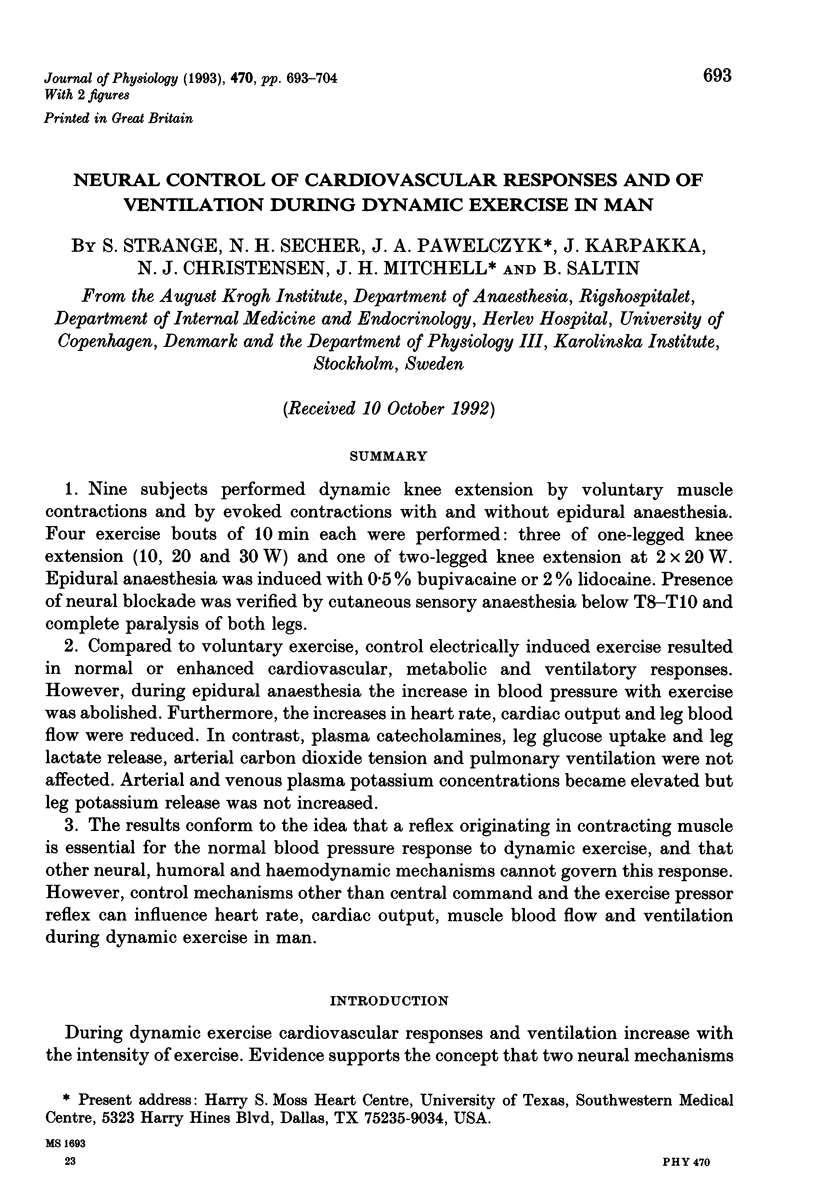
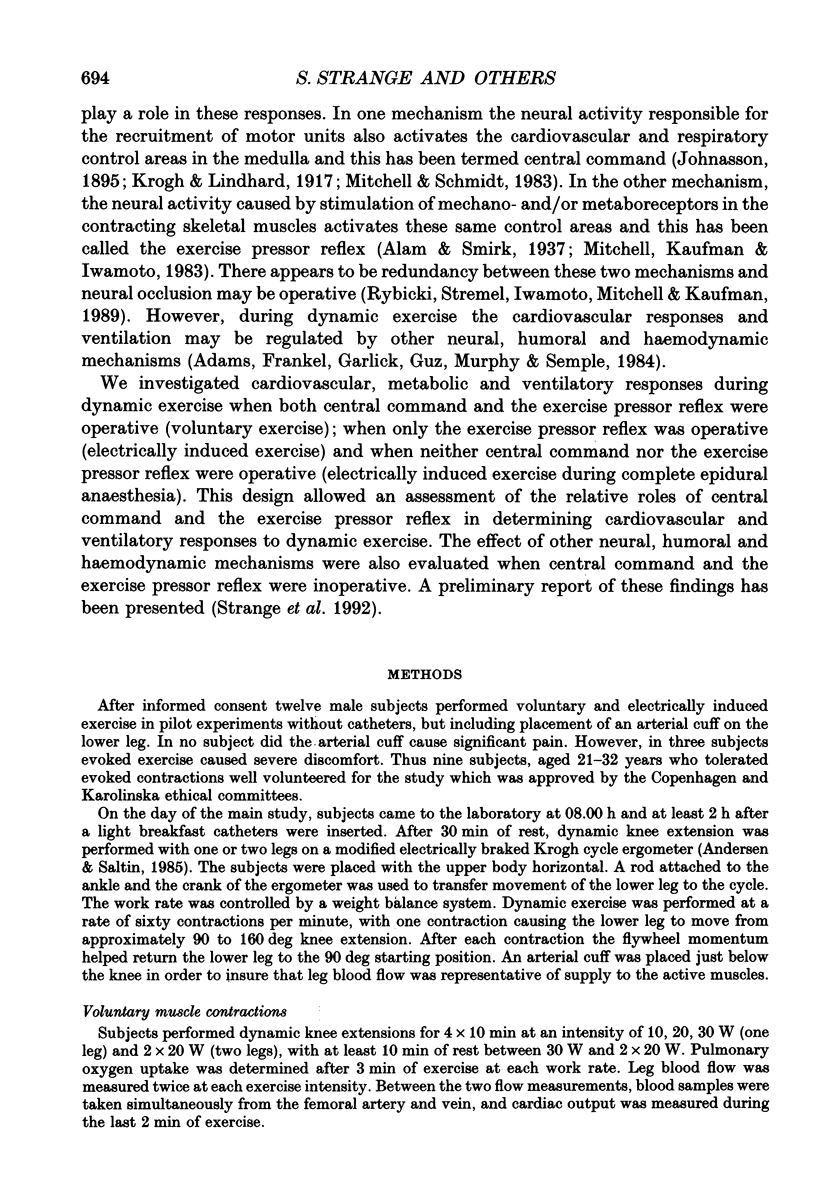
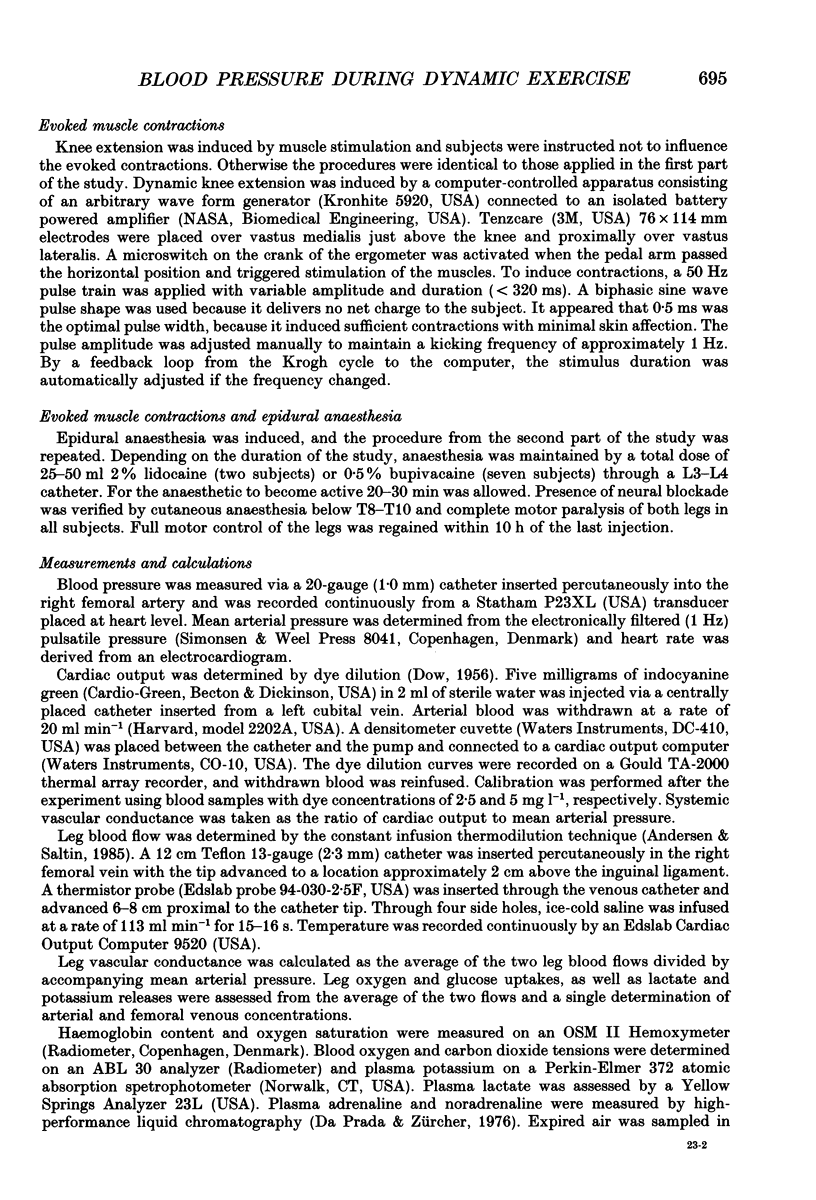
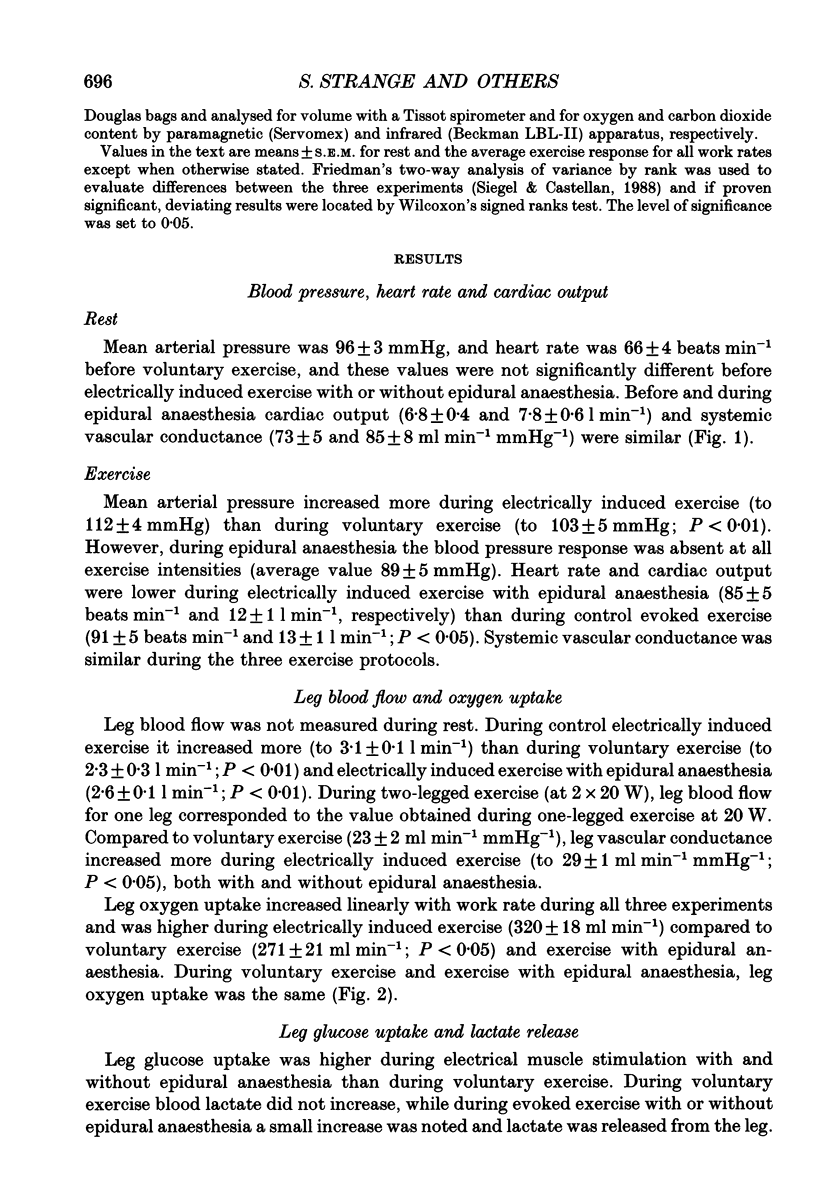
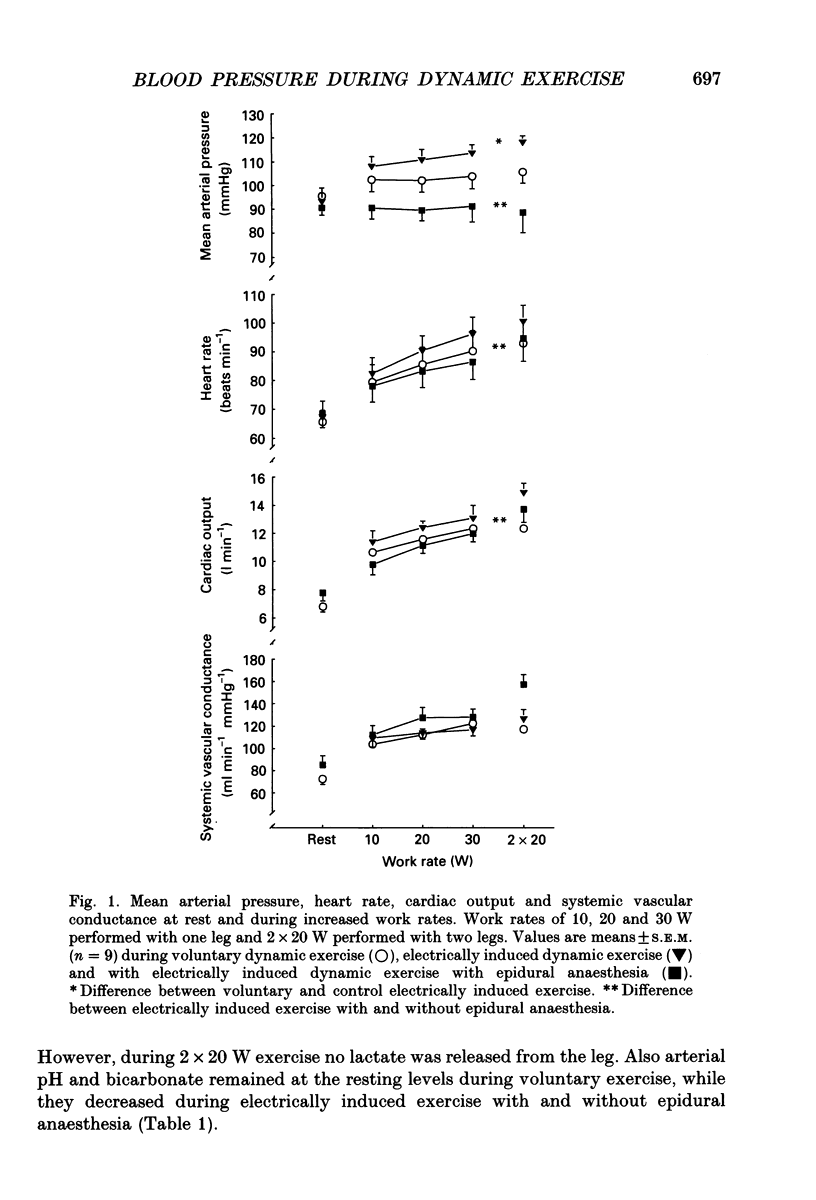
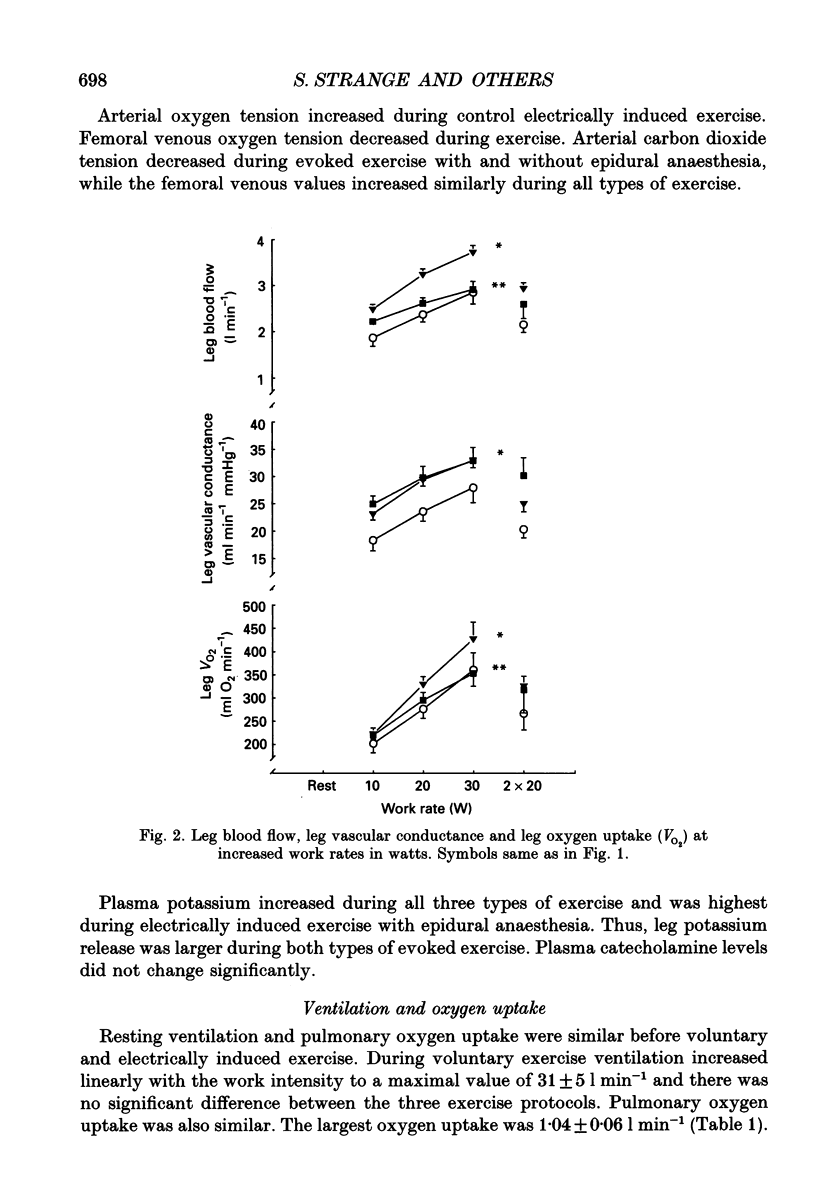
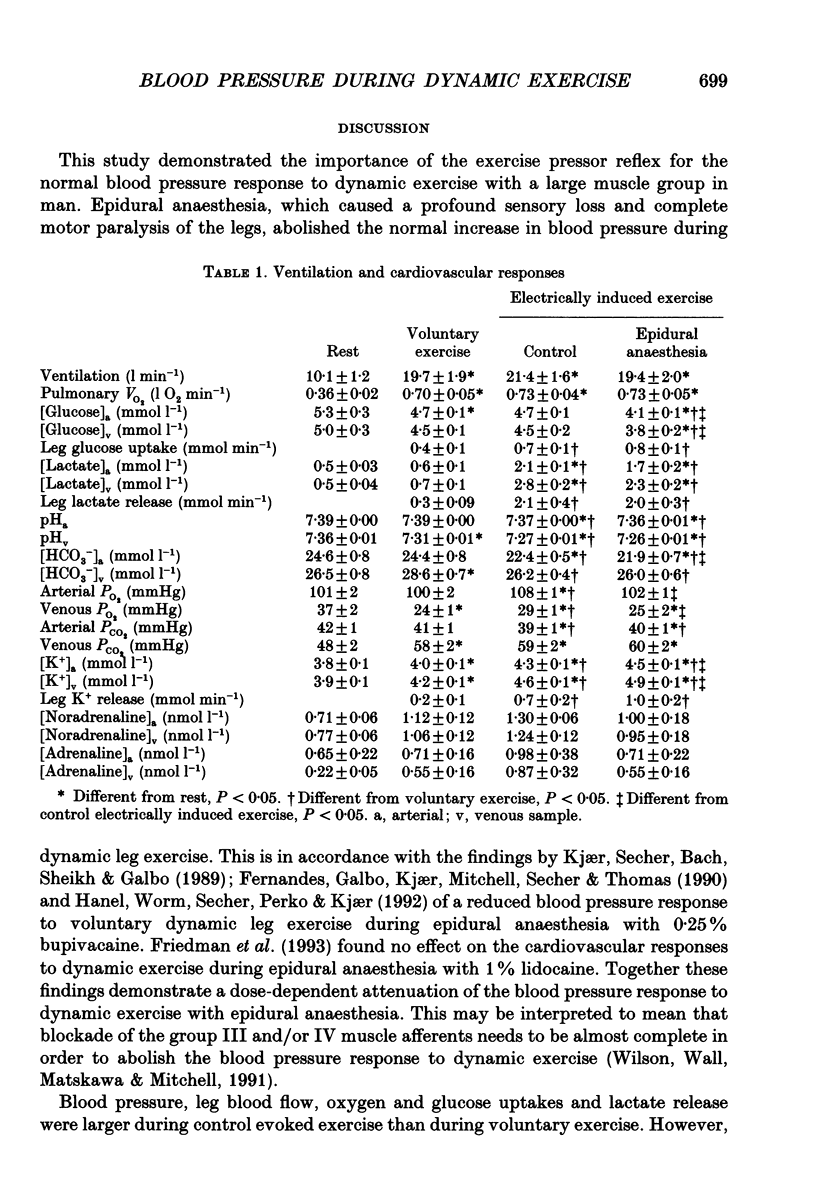
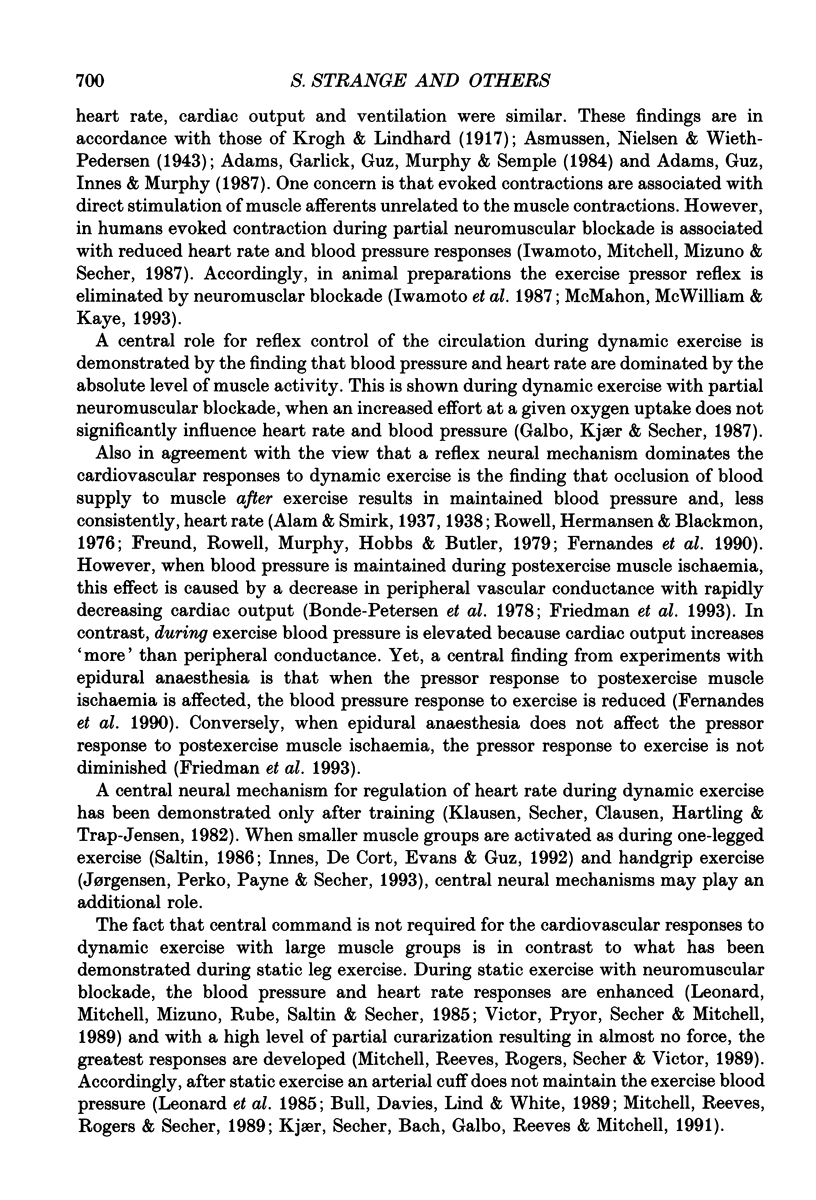
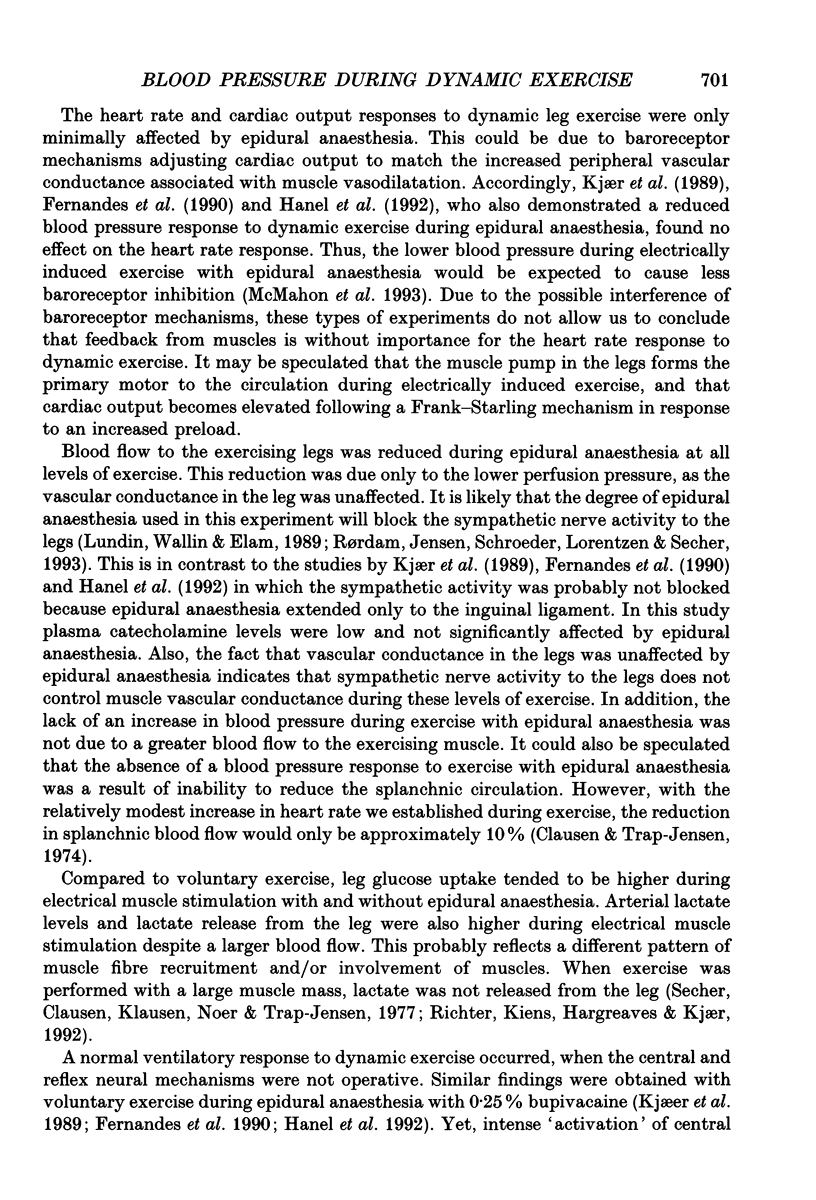
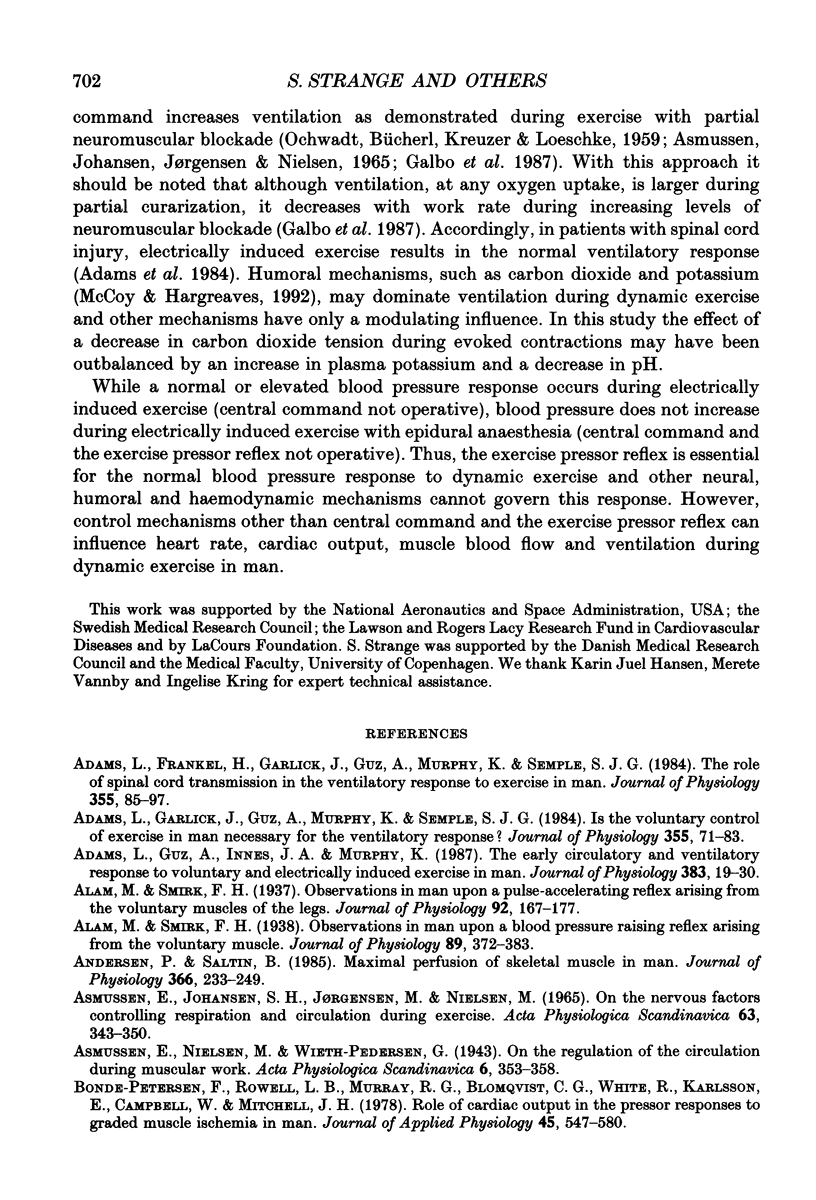
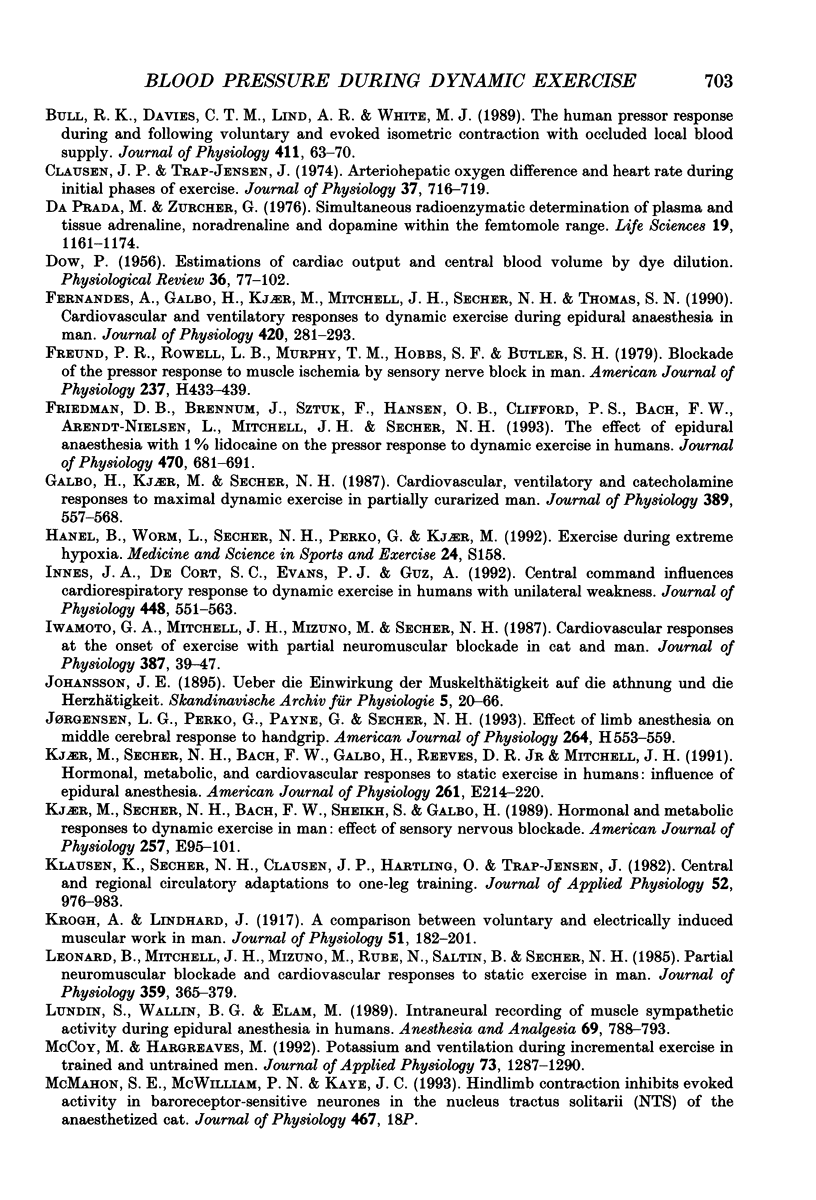
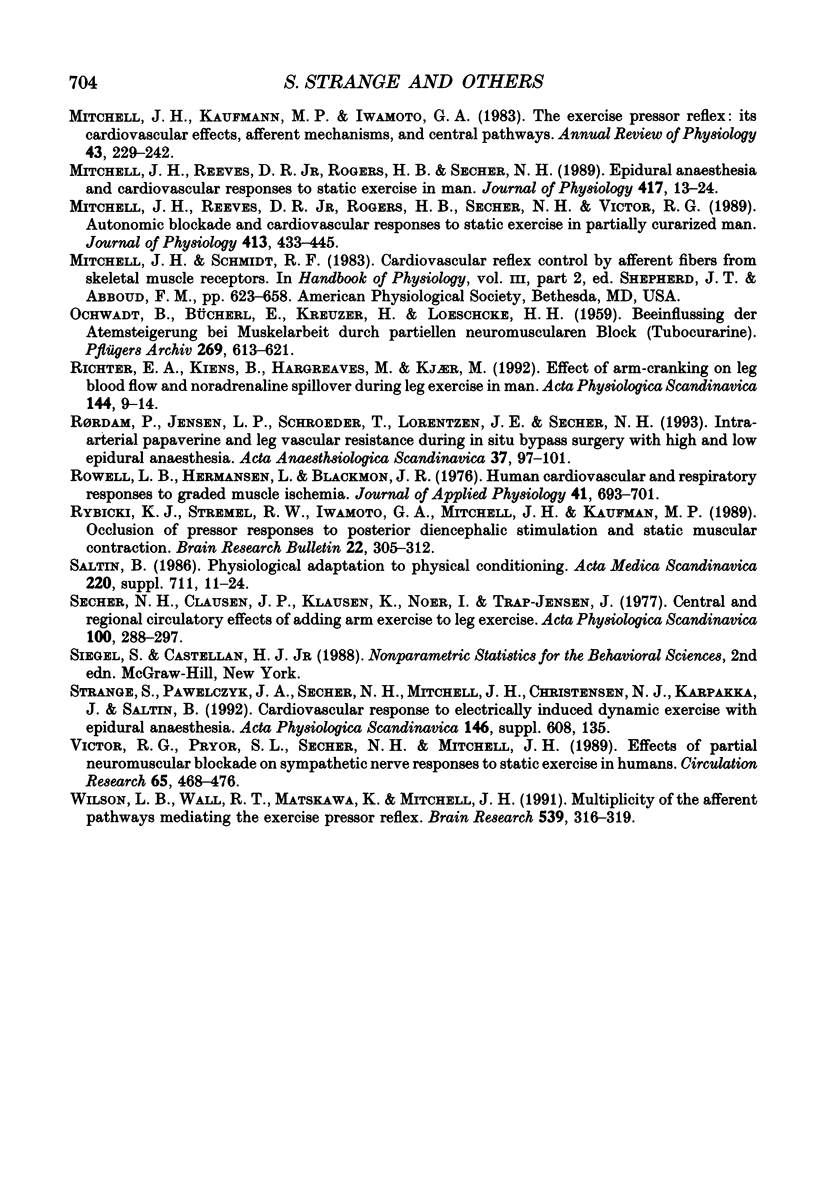
Selected References
These references are in PubMed. This may not be the complete list of references from this article.
- ASMUSSEN E., JOHANSEN S. H., JORGENSEN M., NIELSEN M. ON THE NERVOUS FACTORS CONTROLLING RESPIRATION AND CIRCULATION DURING EXERCISE. EXPERIMENTS WITH CURARIZATION. Acta Physiol Scand. 1965 Mar;63:343–350. doi: 10.1111/j.1748-1716.1965.tb04073.x. [DOI] [PubMed] [Google Scholar]
- Adams L., Frankel H., Garlick J., Guz A., Murphy K., Semple S. J. The role of spinal cord transmission in the ventilatory response to exercise in man. J Physiol. 1984 Oct;355:85–97. doi: 10.1113/jphysiol.1984.sp015408. [DOI] [PMC free article] [PubMed] [Google Scholar]
- Adams L., Garlick J., Guz A., Murphy K., Semple S. J. Is the voluntary control of exercise in man necessary for the ventilatory response? J Physiol. 1984 Oct;355:71–83. doi: 10.1113/jphysiol.1984.sp015407. [DOI] [PMC free article] [PubMed] [Google Scholar]
- Adams L., Guz A., Innes J. A., Murphy K. The early circulatory and ventilatory response to voluntary and electrically induced exercise in man. J Physiol. 1987 Feb;383:19–30. doi: 10.1113/jphysiol.1987.sp016393. [DOI] [PMC free article] [PubMed] [Google Scholar]
- Alam M., Smirk F. H. Observations in man on a pulse-accelerating reflex from the voluntary muscles of the legs. J Physiol. 1938 Mar 14;92(2):167–177. doi: 10.1113/jphysiol.1938.sp003592. [DOI] [PMC free article] [PubMed] [Google Scholar]
- Alam M., Smirk F. H. Observations in man upon a blood pressure raising reflex arising from the voluntary muscles. J Physiol. 1937 Jun 3;89(4):372–383. doi: 10.1113/jphysiol.1937.sp003485. [DOI] [PMC free article] [PubMed] [Google Scholar]
- Andersen P., Saltin B. Maximal perfusion of skeletal muscle in man. J Physiol. 1985 Sep;366:233–249. doi: 10.1113/jphysiol.1985.sp015794. [DOI] [PMC free article] [PubMed] [Google Scholar]
- Bonde-Petersen F., Rowell L. B., Murray R. G., Blomqvist G. G., White R., Karlsson E., Campbell W., Mitchell J. H. Role of cardiac output in the pressor responses to graded muscle ischemia in man. J Appl Physiol Respir Environ Exerc Physiol. 1978 Oct;45(4):574–580. doi: 10.1152/jappl.1978.45.4.574. [DOI] [PubMed] [Google Scholar]
- Bull R. K., Davies C. T., Lind A. R., White M. J. The human pressor response during and following voluntary and evoked isometric contraction with occluded local blood supply. J Physiol. 1989 Apr;411:63–70. doi: 10.1113/jphysiol.1989.sp017560. [DOI] [PMC free article] [PubMed] [Google Scholar]
- Clausen J. P., Trap-Jensen J. Arteriohepatic venous oxygen difference and heart rate during initial phases of exercise. J Appl Physiol. 1974 Nov;37(5):716–719. doi: 10.1152/jappl.1974.37.5.716. [DOI] [PubMed] [Google Scholar]
- DOW P. Estimations of cardiac output and central blood volume by dye dilution. Physiol Rev. 1956 Jan;36(1):77–102. doi: 10.1152/physrev.1956.36.1.77. [DOI] [PubMed] [Google Scholar]
- Da Prada M., Zürcher Simultaneous radioenzymatic determination of plasma and tissue adrenaline, noradrenaline and dopamine within the femtomole range. Life Sci. 1976 Oct 15;19(8):1161–1174. doi: 10.1016/0024-3205(76)90251-4. [DOI] [PubMed] [Google Scholar]
- Fernandes A., Galbo H., Kjaer M., Mitchell J. H., Secher N. H., Thomas S. N. Cardiovascular and ventilatory responses to dynamic exercise during epidural anaesthesia in man. J Physiol. 1990 Jan;420:281–293. doi: 10.1113/jphysiol.1990.sp017912. [DOI] [PMC free article] [PubMed] [Google Scholar]
- Freund P. R., Rowell L. B., Murphy T. M., Hobbs S. F., Butler S. H. Blockade of the pressor response to muscle ischemia by sensory nerve block in man. Am J Physiol. 1979 Oct;237(4):H433–H439. doi: 10.1152/ajpheart.1979.237.4.H433. [DOI] [PubMed] [Google Scholar]
- Friedman D. B., Brennum J., Sztuk F., Hansen O. B., Clifford P. S., Bach F. W., Arendt-Nielsen L., Mitchell J. H., Secher N. H. The effect of epidural anaesthesia with 1% lidocaine on the pressor response to dynamic exercise in man. J Physiol. 1993 Oct;470:681–691. doi: 10.1113/jphysiol.1993.sp019882. [DOI] [PMC free article] [PubMed] [Google Scholar]
- Galbo H., Kjaer M., Secher N. H. Cardiovascular, ventilatory and catecholamine responses to maximal dynamic exercise in partially curarized man. J Physiol. 1987 Aug;389:557–568. doi: 10.1113/jphysiol.1987.sp016672. [DOI] [PMC free article] [PubMed] [Google Scholar]
- Innes J. A., De Cort S. C., Evans P. J., Guz A. Central command influences cardiorespiratory response to dynamic exercise in humans with unilateral weakness. J Physiol. 1992 Mar;448:551–563. doi: 10.1113/jphysiol.1992.sp019057. [DOI] [PMC free article] [PubMed] [Google Scholar]
- Iwamoto G. A., Mitchell J. H., Mizuno M., Secher N. H. Cardiovascular responses at the onset of exercise with partial neuromuscular blockade in cat and man. J Physiol. 1987 Mar;384:39–47. doi: 10.1113/jphysiol.1987.sp016442. [DOI] [PMC free article] [PubMed] [Google Scholar]
- Jørgensen L. G., Perko G., Payne G., Secher N. H. Effect of limb anesthesia on middle cerebral response to handgrip. Am J Physiol. 1993 Feb;264(2 Pt 2):H553–H559. doi: 10.1152/ajpheart.1993.264.2.H553. [DOI] [PubMed] [Google Scholar]
- Kjaer M., Secher N. H., Bach F. W., Galbo H., Reeves D. R., Jr, Mitchell J. H. Hormonal, metabolic, and cardiovascular responses to static exercise in humans: influence of epidural anesthesia. Am J Physiol. 1991 Aug;261(2 Pt 1):E214–E220. doi: 10.1152/ajpendo.1991.261.2.E214. [DOI] [PubMed] [Google Scholar]
- Kjaer M., Secher N. H., Bach F. W., Sheikh S., Galbo H. Hormonal and metabolic responses to exercise in humans: effect of sensory nervous blockade. Am J Physiol. 1989 Jul;257(1 Pt 1):E95–101. doi: 10.1152/ajpendo.1989.257.1.E95. [DOI] [PubMed] [Google Scholar]
- Klausen K., Secher N. H., Clausen J. P., Hartling O., Trap-Jensen J. Central and regional circulatory adaptations to one-leg training. J Appl Physiol Respir Environ Exerc Physiol. 1982 Apr;52(4):976–983. doi: 10.1152/jappl.1982.52.4.976. [DOI] [PubMed] [Google Scholar]
- Krogh A., Lindhard J. A comparison between voluntary and electrically induced muscular work in man. J Physiol. 1917 Jul 3;51(3):182–201. doi: 10.1113/jphysiol.1917.sp001795. [DOI] [PMC free article] [PubMed] [Google Scholar]
- Leonard B., Mitchell J. H., Mizuno M., Rube N., Saltin B., Secher N. H. Partial neuromuscular blockade and cardiovascular responses to static exercise in man. J Physiol. 1985 Feb;359:365–379. doi: 10.1113/jphysiol.1985.sp015590. [DOI] [PMC free article] [PubMed] [Google Scholar]
- Lundin S., Wallin B. G., Elam M. Intraneural recording of muscle sympathetic activity during epidural anesthesia in humans. Anesth Analg. 1989 Dec;69(6):788–793. [PubMed] [Google Scholar]
- McCoy M., Hargreaves M. Potassium and ventilation during incremental exercise in trained and untrained men. J Appl Physiol (1985) 1992 Oct;73(4):1287–1290. doi: 10.1152/jappl.1992.73.4.1287. [DOI] [PubMed] [Google Scholar]
- Mitchell J. H., Kaufman M. P., Iwamoto G. A. The exercise pressor reflex: its cardiovascular effects, afferent mechanisms, and central pathways. Annu Rev Physiol. 1983;45:229–242. doi: 10.1146/annurev.ph.45.030183.001305. [DOI] [PubMed] [Google Scholar]
- Mitchell J. H., Reeves D. R., Jr, Rogers H. B., Secher N. H. Epidural anaesthesia and cardiovascular responses to static exercise in man. J Physiol. 1989 Oct;417:13–24. doi: 10.1113/jphysiol.1989.sp017787. [DOI] [PMC free article] [PubMed] [Google Scholar]
- Mitchell J. H., Reeves D. R., Jr, Rogers H. B., Secher N. H., Victor R. G. Autonomic blockade and cardiovascular responses to static exercise in partially curarized man. J Physiol. 1989 Jun;413:433–445. doi: 10.1113/jphysiol.1989.sp017662. [DOI] [PMC free article] [PubMed] [Google Scholar]
- OCHWADT B., BUECHERL E., KREUZER H., LOESCHCKE H. H. [Modification of respiratory increase in muscular work by partial neuromuscular block (tubocurarine)]. Pflugers Arch Gesamte Physiol Menschen Tiere. 1959;269:613–621. [PubMed] [Google Scholar]
- Richter E. A., Kiens B., Hargreaves M., Kjaer M. Effect of arm-cranking on leg blood flow and noradrenaline spillover during leg exercise in man. Acta Physiol Scand. 1992 Jan;144(1):9–14. doi: 10.1111/j.1748-1716.1992.tb09261.x. [DOI] [PubMed] [Google Scholar]
- Rowell L. B., Hermansen L., Blackmon J. R. Human cardiovascular and respiratory responses to graded muscle ischemia. J Appl Physiol. 1976 Nov;41(5 Pt 1):693–701. doi: 10.1152/jappl.1976.41.5.693. [DOI] [PubMed] [Google Scholar]
- Rybicki K. J., Stremel R. W., Iwamoto G. A., Mitchell J. H., Kaufman M. P. Occlusion of pressor responses to posterior diencephalic stimulation and muscular contraction. Brain Res Bull. 1989 Feb;22(2):305–312. doi: 10.1016/0361-9230(89)90058-0. [DOI] [PubMed] [Google Scholar]
- Rørdam P., Jensen L. P., Schroeder T., Lorentzen J. E., Secher N. H. Intra-arterial papaverine and leg vascular resistance during in situ bypass surgery with high or low epidural anaesthesia. Acta Anaesthesiol Scand. 1993 Jan;37(1):97–101. doi: 10.1111/j.1399-6576.1993.tb03607.x. [DOI] [PubMed] [Google Scholar]
- Saltin B. Physiological adaptation to physical conditioning. Old problems revisited. Acta Med Scand Suppl. 1986;711:11–24. doi: 10.1111/j.0954-6820.1986.tb08928.x. [DOI] [PubMed] [Google Scholar]
- Secher N. H., Clausen J. P., Klausen K., Noer I., Trap-Jensen J. Central and regional circulatory effects of adding arm exercise to leg exercise. Acta Physiol Scand. 1977 Jul;100(3):288–297. doi: 10.1111/j.1748-1716.1977.tb05952.x. [DOI] [PubMed] [Google Scholar]
- Victor R. G., Pryor S. L., Secher N. H., Mitchell J. H. Effects of partial neuromuscular blockade on sympathetic nerve responses to static exercise in humans. Circ Res. 1989 Aug;65(2):468–476. doi: 10.1161/01.res.65.2.468. [DOI] [PubMed] [Google Scholar]
- Wilson L. B., Wall P. T., Matsukawa K., Mitchell J. H. Multiplicity of the afferent pathways mediating the exercise pressor reflex. Brain Res. 1991 Jan 25;539(2):316–319. doi: 10.1016/0006-8993(91)91636-f. [DOI] [PubMed] [Google Scholar]


